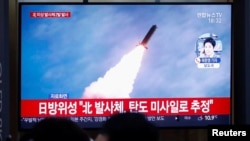North Korea confirmed Friday it tested a “super large multiple rocket launcher,” the latest reminder of Pyongyang's end-of-year deadline for nuclear talks.
The official Korean Central News Agency said leader Kim Jong Un oversaw the “volley test-fire” on Thursday and “expressed satisfaction” with the results.
It is North Korea's 13th round of weapons tests since early May, making 2019 one of its busiest years for missile tests.
Kim has given the United States until the end of the year to make concessions in nuclear talks that have been stalled since February.
South Korea’s military said the North fired two projectiles, which traveled about 380 kilometers at an altitude of 97 kilometers before splashing into the ocean.
The test involved the KN-25 multiple rocket launch system, a short-range weapons system that Pyongyang has tested several times this year.
By repeatedly testing the KN-25, defense analysts say North Korea has successfully reduced the amount of time it takes to launch successive rockets from the system.
“The faster it fires, the quicker it can out of dodge before counter-fire arrives,” Jeffrey Lewis, an expert in nuclear nonproliferation with the Middlebury Institute of International Studies at Monterey, said on Twitter.
During the first two tests of the KN-25 in August and September, it took between 15 and 20 minutes between launches. In a subsequent October test, that number was reduced to 3 minutes. On Thursday, Seoul’s military estimated there were only 30 seconds between shots.
North Korean state media on Friday proclaimed the test a success.
"The volley test-fire aimed to finally examine the combat application of the super-large, multiple-launch rocket system proved the military and technical superiority of the weapon system and its firm reliability,” KCNA said.
In addition to advancing its weapons arsenal, the North Korean tests appear aimed at applying more pressure on the U.S. ahead of Kim’s end-of-year deadline for nuclear talks.
North Korea last month walked out of working-level nuclear negotiations, blaming Washington for the breakdown. Pyongyang has since warned it could restart nuclear or longer-range missile tests.
Last week, Kim visited a frontline island near the disputed inter-Korean sea border off the western coast and ordered troops there to conduct an artillery drill.
Kim and U.S. President Donald Trump have met three times since June 2018, but have failed to make any progress on dismantling North Korea’s nuclear weapons.
Talks have been stalled since February, when a summit in Hanoi between Kim and Trump ended in a disagreement over how to pace sanctions relief with steps to dismantle North Korea's nuclear program.
Almost all of North Korea's missile test this year have been short range. Trump has said he has “no problem” with North Korea’s short-range launches, since they cannot reach the United States.
The latest launch came as the United States began celebrating the Thanksgiving holiday on Thursday. It is only the second time this year North Korea has launched a missile in the evening. All other launches this year have occurred in the early morning hours.
“North Korea has a keen sense of timing and the political calendar in the US. With the Trump impeachment hearings going on and Thanksgiving, and year-end holidays just around the corner, Pyongyang is ramping up pressure and setting the stage for blaming the U.S. for the next big provocation,” Sung-Yoon Lee, a Korea expert at Tufts University's Fletcher School, said.








